金属有机化学反应与应用催化
1. Mononuclear ruthenium(II) complexes supported by 1,4,7-trimethyl-1,4,7-triazacyclononane (Me3tacn) ligands
Treatment of ruthenium(II) precursor [(Me3tacn)Ru(dmso)Cl2] (Me3tacn = 1,4,7-trimethyl-1,4,7-triazacyclononane, dmso = dimethylsulfoxide) (1) with concentrated HCl in the presence of air afforded a ruthenium(III) complex [(Me3tacn)RuCl3·H2O] (2). Reaction of 2, 2,2′-bipyridine or substituted 2,2′-bipyridine, and zinc metal powder in the presence of sodium perchlorate gave the corresponding cationic aquaruthenium(II) complex [(Me3tacn)Ru(R-bpy)(H2O)](ClO4)2 (bpy = 2,2′-bipyridine, R = H, 3; 4,4′-Me2, 4; 5,5′-Me2, 5; 4,4′-di-tBu, 6). The hydrate ligand in complexes 3 and 5 could be substituted by acetonitrile or pyridine forming complexes [(Me3tacn)Ru(5,5′-Me2-bpy)(CH3CN)](ClO4)2 (7) and [(Me3tacn)Ru(R-bpy)(py)](ClO4)2 (py = pyridine, R = H (8), R = 5,5′-Me2 (9), respectively. Interaction of [(Me3tacn)Ru(bpy)(H2O)](PF6)2 with phenylacetylene in methanol afforded a ruthenium-carbene complex [(Me3tacn)(bpy)Ru=C(OMe)CH2Ph](PF6)2 (10). The photocatalysis properties of ruthenium complexes for H2 evolution by water splitting were also investigated in the paper.
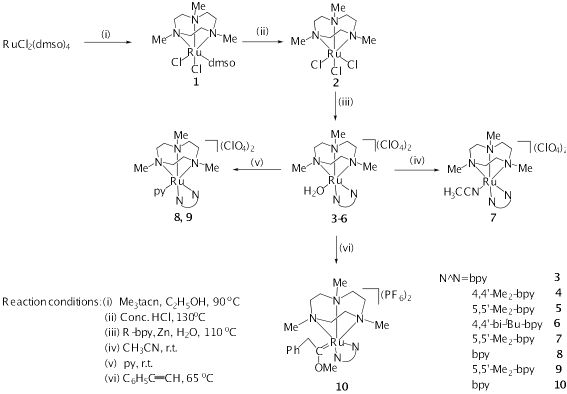
Synthesis and reactivity of ruthenium complexes with Me3tacn ligands. 
Molecular structures of bipydine ruthenium conplexes
2. Adducts of ruthenium(IV) thiolates with substituted pyridines. Syntheses and structures of [Ru(SMes)4(R-py)] (R = 4-Et, 4-tBu, and 3,5-Me2) and [{Ru(SMes)4}2(μ-4,4′-bipy)] (Mes = 2,4,6-trimethylphenyl)
Treatment of the trigonal-bipyramidal ruthenium(IV)–thiolate complex, [Ru(SMes)4(MeCN)] (Mes = 2,4,6-trimethylphenyl, 1), with an anhydrous diethyl ether solution of hydrogen chloride in THF afforded [Ru(SMes)3Cl(MeCN)] (2), whereas interaction of 1 with [Et4N]Cl in THF gave an anionic ruthenium(IV)–thiolate complex, [Et4N][Ru(SMes)4Cl] (3). Reaction of 1 with one equivalent of substituted pyridines in dichloromethane gave the corresponding pyridine-coordinated ruthenium(IV)–thiolate complexes, [Ru(SMes)4(R-py)] (R = 4-Et, 4; 4-tBu, 5; 3,5-Me2, 6), while reaction of 1 with 0.5 equiv. of 4,4′-bipy (4,4′-bipy = 4,4′-bipyridine) in dichloromethane resulted in the formation of a dinuclear ruthenium(IV)–thiolate complex [{Ru(SMes)4}2(μ-4,4′-bipy)] (7).

Reactions of the ruthenium(IV)–thiolate complex [Ru(SMes)4(MeCN)]

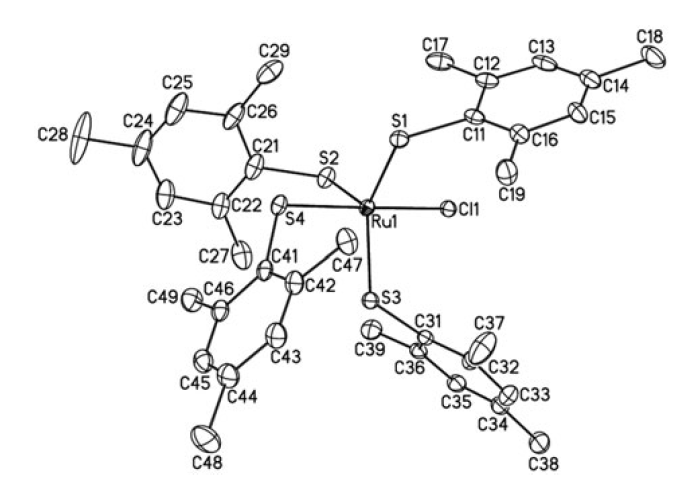
Molecular structure of ruthenium complexes
3. Synthesis and characterization of ruthenium complexes with 1-aryl-2-mercaptoimidazole ligands
Reactions of the vinyl ruthenium starting material Ru(CH=CHPh)Cl(CO)(PPh3)2 (1) with 1-aryl-2-mercaptoimidazole (HLa, aryl = 4-chloro-phenyl; HLb, aryl = 4-methyl-phenyl; HLc, aryl = 4-nitrophenyl) in the presence of sodium methoxide in dichloromethane and methanol afforded [Ru(CH=CHPh)(ĸ2-L)(CO)(PPh3)2] (2a−2c). Treatment of 1 with HL in THF gave [RuCl(ĸ2-L)(CO)(PPh3)2] (3a−3c) contaminant with formation of styrene as byproduct. Interactions of 1 with HLa in dichloromethane led to isolation of a novel dinuclear ruthenium complex [(CO)(PPh3)(CHNCH2Ph)Ru(μ-Cl)2(μ-S)RuCl(-CO)(PPh3)] (4a) via N−H bond addition to styryl ligand.
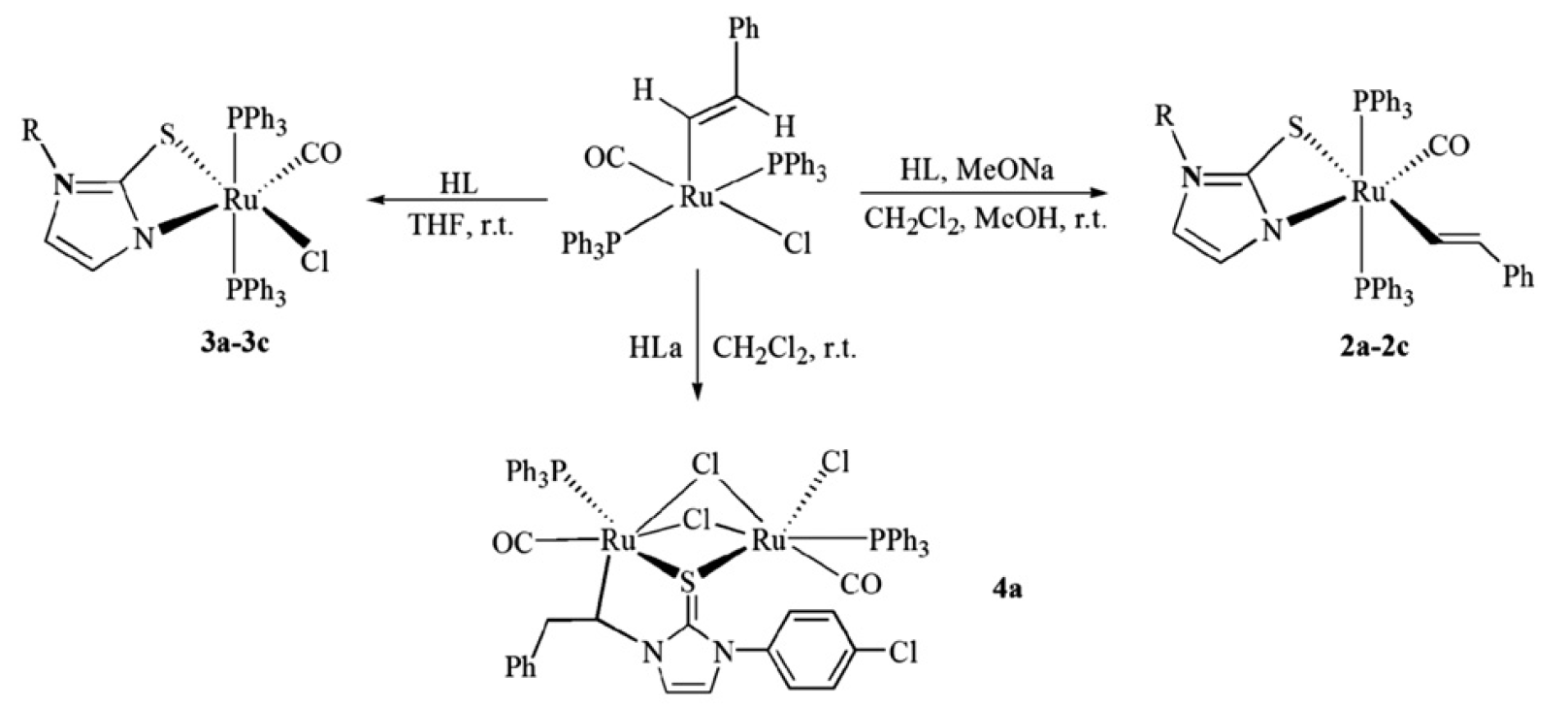
Synthesis of Ruthenium Complexes

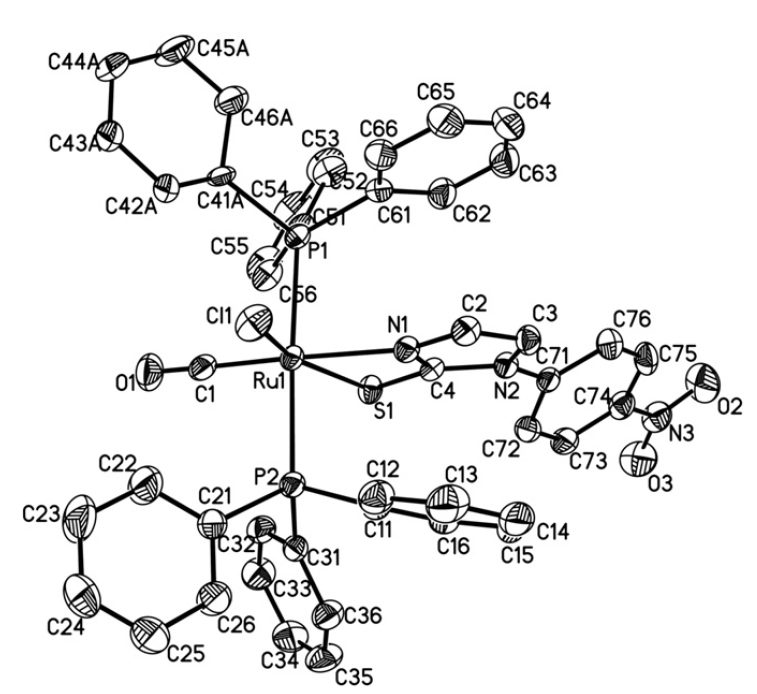
Molecular structure of ruthenium complexes
4. Syntheses, structures and immobilization of ruthenium complexes bearing N,O-Schiff-base or N,N′-diamine ligands functionalized with alkoxysilyl groups
Condensation of γ-aminopropyltriethoxysilane and substituted salicylaldehydes in ethanol afforded three new Schiff-base compounds [(EtO)3Si(CH2)3N=CHArOH] (Ar = C6H4, L1H; C6H3(4-Cl), L2H; C6H2(2,4-tBu2), L3H). Treatment of [Ru(NO)Cl3·xH2O] with L1H in the presence of Et3N in THF gave a ruthenium nitrosyl complex [RuCl2(NO)(ĸ2-O,N-L1)(OEt2)] (1) with a linear N≡O moiety. Reactions of [(η6-p-cymene)RuCl(μ-Cl)]2 with L1H or L2H in the presence of AgNO3 and Et3N afforded complexes [(η6-p-cymene)RuCl(ĸ2-O,N-L)] (L = L1, 2; L2, 3). While reaction of [Ru(CO)2Cl2]n and L3H in the presence of Et3N afforded an anionic ruthenium complex (Et3NH)[RuCl2(CO)2(ĸ2-O,N-L3)] (4). Treatment of alkoxysilyl functionalized N,N′-diamine compound N1-(3-(trimethoxysilyl)propyl)ethane-1,2-diamine (L4) with [Ru(PPh3)3Cl2] or [Ru(DMSO)4Cl2] (DMSO = dimethyl sulfoxide) or [Ru(COD)Cl2]x (COD = 1,5-cyclooctadiene) led to formation of complexes [Ru(PPh3)2Cl2(ĸ2N-L4)] (5), [Ru(DMSO)2Cl2(ĸ2N-L4)] (6), and [Ru(COD)Cl2(ĸ2N-L4)] (7). Immobilization of complexes 2 and 5 on SBA-15, and characterization of these hybrid heterogeneous catalysts were studied by transmission electron microscopy (TEM), IR and low pressure N2 adsorption/desorption measurement. The heteroge-neous catalysts were also briefly tested for oxidation of benzyl alcohol to benzaldehyde.
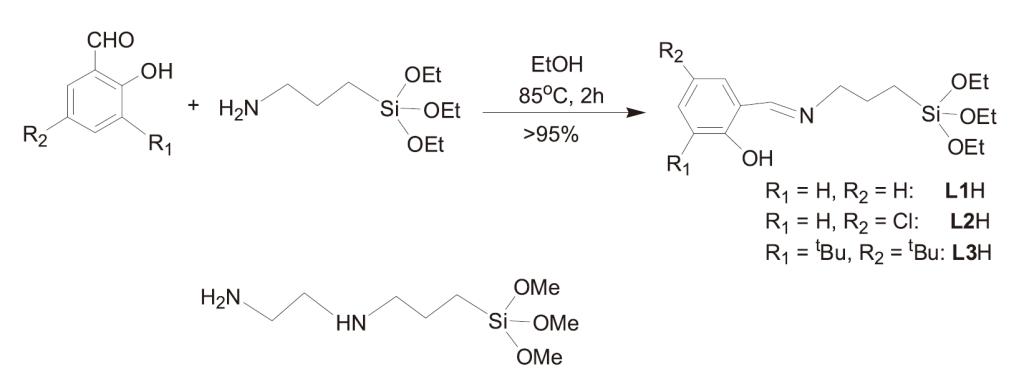
Syntheses of N,O-Schiff bases (L1H, L2H, L3H) and schematic representation of N,N′-diamine ligand L4.

Syntheses of ruthenium complexes 1−4 with N,O-bidentate Schiff-base ligands bearing ethoxysilyl groups.
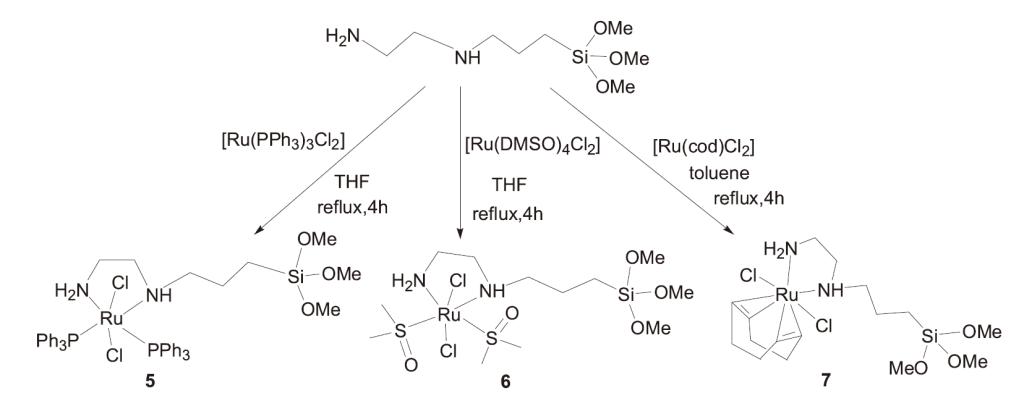
Syntheses of ruthenium complexes 5−7 with N,N′-bidentate diamine ligands bearing methoxysilyl groups.